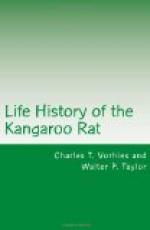RUNWAYS AND TRACKS.
Still other features add to the interest in the dwelling places of spectabilis. Radiating in various directions from some of the openings of the mounds well-used runways are to be seen, some of them fading out in the surrounding vegetation, but others extending 30, 40, or even 50 or more yards to neighboring burrows or mounds (Pl. V, Fig. 2; Pl. VI, Fig. 1). These runways and the entrances to the mounds are well worn, showing that the inhabitants are at home and are at some time of day very active. The worn paths become most conspicuous in the autumnal harvest season, when they stand out in strong contrast to surrounding grass. One usually finds not far distant from the main habitation one or more smaller burrows, each with from one to three typical openings, connected by the trail or runway system with the central den, and these we have called “subsidiary burrows” (Pl. VI, Fig. 2). These will be again referred to in discussing the detailed plan of the entire shelter system.
Examination of the runways and of the denuded area about a mound discloses an abundance of almost indecipherable tracks. The dust or sand is ordinarily much too dry and shifting to record clear footprints, and there are no opportunities to see footprints of this species recorded in good impressionable soil. Very characteristic traces of kangaroo rats may be readily observed in the dust about the mounds, however, and these are long, narrow, sometimes curving, furrows made by the long tails as the animals whisk about their work or play.
[Illustration: PLATE V. FIG. 1.—CLEARING ABOUT A MOUND.
A typical clearing about a mound of Dipodomys s. spectabilis, showing the autumnal denudation of the mound and surrounding areas. In this instance about 30 feet in diameter.]
[Illustration: PLATE V. FIG. 2.—MOUND AND RUNWAYS.
A small mound of Dipodomys s. spectabilis in early autumn, showing runways radiating from the den. Evidences of activity may be noted in and about the surface of the mound.]
[Illustration: PLATE VI. FIG. 1.—RUNWAY OF DIPODOMYS S. SPECTABILIS.
Well-traveled path leading from the main den, in the foreground, to a subsidiary burrow (see Fig. 2, below), about 30 feet distant, at apparent end of runway.]
[Illustration: PLATE VI. FIG. 2.—SUBSIDIARY BURROW OF DIPODOMYS S. SPECTABILIS.




